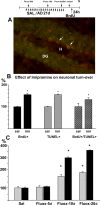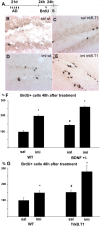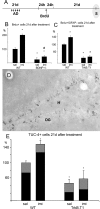Brain-derived neurotrophic factor and antidepressant drugs have different but coordinated effects on neuronal turnover, proliferation, and survival in the adult dentate gyrus
- PMID: 15689544
- PMCID: PMC6725966
- DOI: 10.1523/JNEUROSCI.3741-04.2005
Brain-derived neurotrophic factor and antidepressant drugs have different but coordinated effects on neuronal turnover, proliferation, and survival in the adult dentate gyrus
Abstract
Antidepressants increase proliferation of neuronal progenitor cells and expression of brain-derived neurotrophic factor (BDNF) in the hippocampus. We investigated the role of BDNF signaling in antidepressant-induced neurogenesis by using transgenic mice with either reduced BDNF levels (BDNF+/-) or impaired trkB activation (trkB.T1-overexpressing mice). In both transgenic strains, chronic (21 d) imipramine treatment increased the number of bromodeoxyuridine (BrdU)-positive cells to degree similar to that seen in wild-type mice 24 h after BrdU administration, although the basal proliferation rate was increased in both transgenic strains. Three weeks after BrdU administration and the last antidepressant injection, the amount of newborn (BrdU- or TUC-4-positive) cells was significantly reduced in both BDNF+/- and trkB.T1-overexpressing mice, which suggests that normal BDNF signaling is required for the long-term survival of newborn hippocampal neurons. Moreover, the antidepressant-induced increase in the surviving BrdU-positive neurons seen in wild-type mice 3 weeks after treatment was essentially lost in mice with reduced BDNF signaling. Furthermore, we observed that chronic treatment with imipramine or fluoxetine produced a temporally similar increase in both BrdU-positive and terminal deoxynucleotidyl transferase-mediated biotinylated UTP nick end-labeled neurons in the dentate gyrus, indicating that these drugs simultaneously increase both neurogenesis and neuronal elimination. These data suggest that antidepressants increase turnover of hippocampal neurons rather than neurogenesis per se and that BDNF signaling is required for the long-term survival of newborn neurons in mouse hippocampus.
Figures



References
-
- Altar CA (1999) Neurotrophins and depression. Trends Pharmacol Sci 20: 59-61. - PubMed
-
- Barde Y-A (1989) Trophic factors and neuronal survival. Neuron 2: 1525-1534. - PubMed
-
- Castrén E (2004) Neurotrophic effects of antidepressant drugs. Curr Opin Pharmacol 4: 58-64. - PubMed
-
- Chen B, Dowlatshahi D, MacQueen GM, Wang JF, Young LT (2001) Increased hippocampal BDNF immunoreactivity in subjects treated with antidepressant medication. Biol Psychiatry 50: 260-265. - PubMed
Publication types
MeSH terms
Substances
LinkOut - more resources
Full Text Sources
Other Literature Sources
Medical
